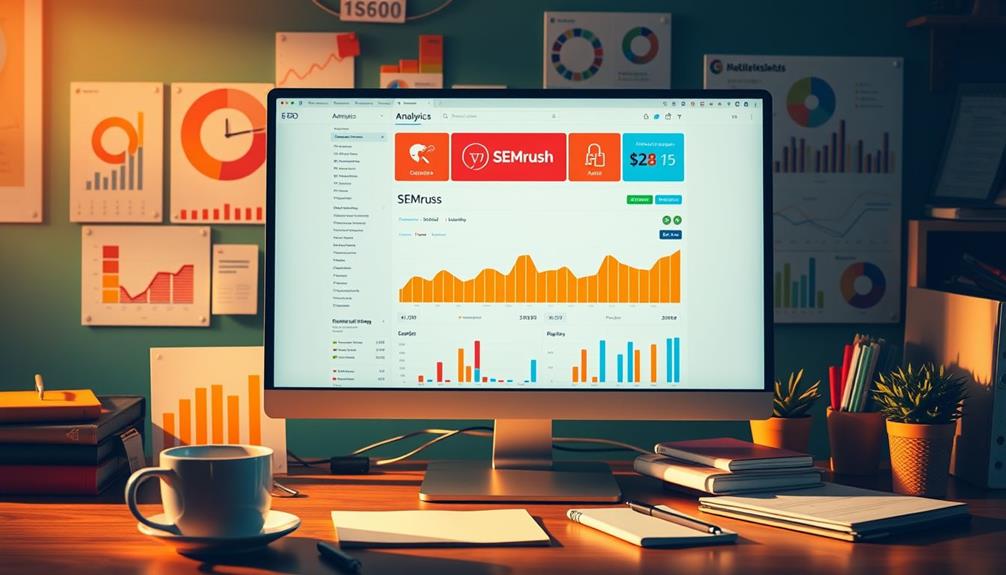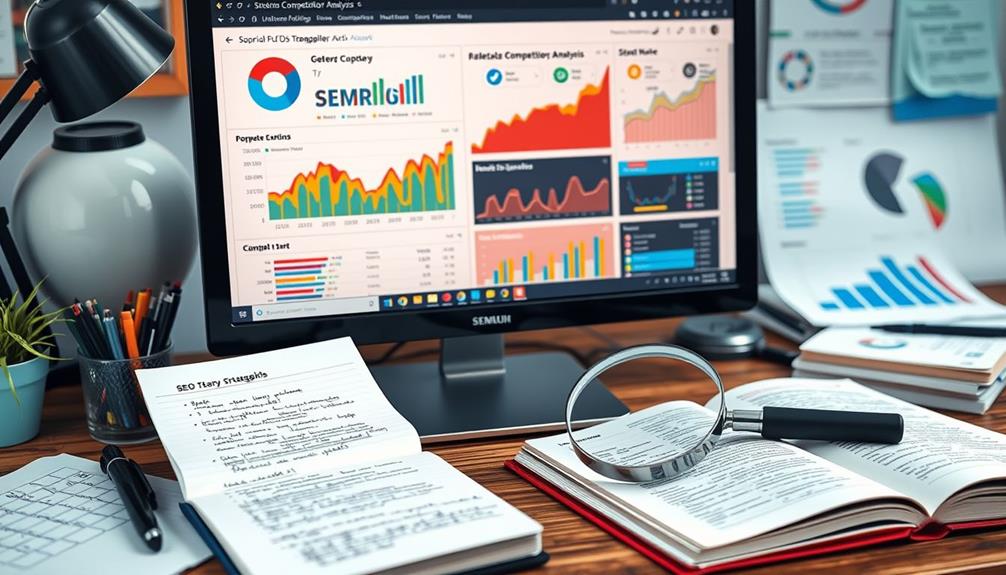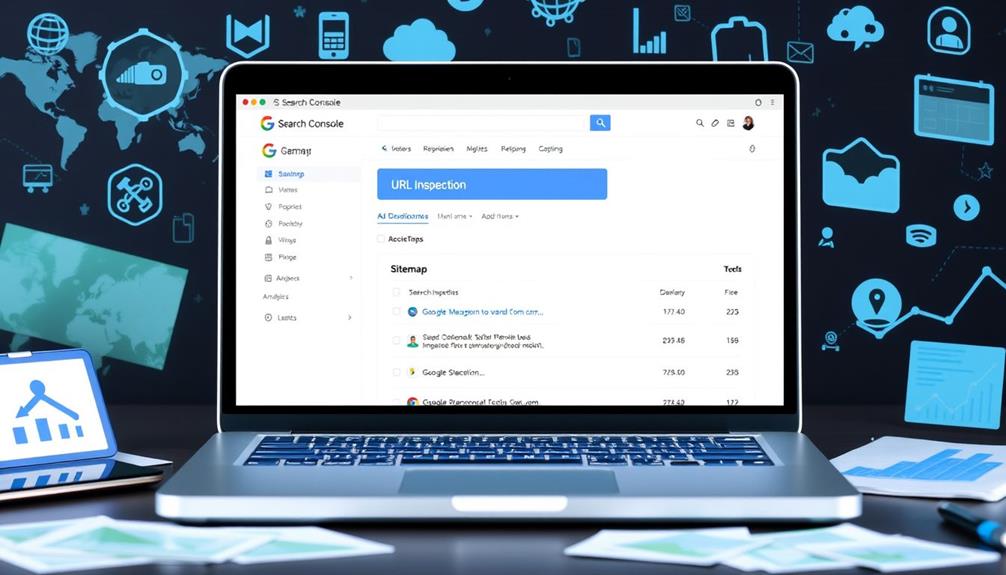Holistic SEO
LinkedIn Content Strategy for B2B Lead Generation
Achieve B2B lead generation success on LinkedIn by mastering content strategies that captivate your audience—discover the secrets to effective engagement.

To boost your B2B lead generation on LinkedIn, start by optimizing your profile and creating engaging content that resonates with your audience. Use diverse formats like videos and infographics to capture attention and address their pain points with educational materials. Personalize your outreach to build genuine connections, which can enhance acceptance rates markedly. Join relevant groups and participate actively to showcase your expertise and interact with potential leads. Analyze your content performance regularly to refine your strategies. There's much more to explore about maximizing your impact and ensuring your efforts yield results.
Key Takeaways
- Optimize your LinkedIn profile with engaging headlines and summaries to attract quality leads and increase visibility by 40%.
- Create diverse, high-quality content formats to address audience pain points and encourage engagement, boosting connection requests ninefold.
- Actively participate in relevant LinkedIn groups to establish authority, enhance visibility, and connect with potential leads through shared insights.
- Utilize customer testimonials and case studies in your content to build credibility and demonstrate value, increasing conversion rates by 300%.
- Regularly analyze content performance using LinkedIn analytics to refine your strategy and improve audience engagement effectively.
Importance of B2B Lead Generation
B2B lead generation is a cornerstone of business success, driving sales and revenue growth.
It's essential for you to understand that 85% of marketers consider lead generation a key goal, emphasizing its vital role in your business strategy.
Effective keyword and content strategy can markedly enhance your visibility and engagement on platforms like LinkedIn.
LinkedIn stands out as the most effective channel, accounting for 97% of B2B social media leads. By leveraging this platform, you can connect with potential customers who are actively looking for solutions.
Creating engaging content that addresses your audience's pain points is essential.
This type of content builds trust and establishes credibility, making it easier for you to nurture leads.
Personalized engagement can markedly boost conversion rates, turning prospects into paying customers.
Research shows that 40% of B2B marketers view LinkedIn as the best platform for quality leads, with conversion rates up to three times higher than other social media.
Maximizing LinkedIn for Leads

To maximize your leads on LinkedIn, start by optimizing your profile visibility to attract the right audience.
Incorporating testimonials to enhance credibility can further establish your authority and increase trust among potential connections.
Engaging consistently with targeted connections can greatly boost your chances of generating quality leads.
Optimize Profile Visibility
A well-optimized LinkedIn profile can be your strongest asset for attracting leads in the competitive B2B landscape. To truly optimize your LinkedIn profile, start with engaging headlines and a compelling summary that highlights your unique value proposition. This approach greatly enhances your profile visibility, making you more attractive to potential prospects.
Incorporating an understanding of AI advancements can further refine your strategy, allowing you to leverage technology for enhanced outreach.
Don't underestimate the power of a professional visual; profiles with high-quality images receive up to 21 times more views, boosting your chances of generating B2B leads. Additionally, regularly sharing valuable content positions you as an industry authority, which can lead to nine times more connection requests and potential leads.
Another key area to focus on is the Skills & Endorsements section. By optimizing this part of your profile, you enhance your credibility and increase your search visibility, making it easier for relevant prospects to discover you.
Engage With Target Audience
While engaging with your target audience on LinkedIn is essential, it's how you do it that makes all the difference. A strong content strategy focuses on sharing valuable content that resonates with your audience's interests. By doing this, you can increase your profile visibility by 50%, which enhances your chances of lead generation. Incorporating elements of website interaction can further elevate your content's effectiveness.
Consider using polls and questions in your posts. These techniques encourage interaction, making your content more engaging and increasing the likelihood of capturing leads.
Additionally, actively participating in LinkedIn Groups allows you to have meaningful conversations with potential leads, establishing yourself as a credible source of industry information.
Don't forget about personalized outreach. Tailoring your messages to connections greatly improves response rates, making it easier for you to nurture relationships and convert leads into customers.
Regularly sharing quality content can also lead to nine times more connection requests, which expands your network and increases your potential leads.
Optimizing Your Profile

Your LinkedIn profile serves as your digital business card, and optimizing it's essential for attracting potential leads. A complete profile can yield 40% more opportunities, so it's vital to showcase your professional identity effectively.
Start with engaging headlines and a compelling summary that clearly convey your value proposition, enhancing your visibility to attract the right audience. Effective advertisement formats play a significant role in capturing the attention of your target audience, much like how a well-crafted LinkedIn profile can draw in potential connections.
Include relevant skills and seek endorsements, as these elements boost your credibility and improve your search visibility. Professional networking thrives on trust, and displaying your expertise can set you apart in the B2B landscape.
Don't underestimate the power of high-quality visuals; they can increase your profile views by up to 21 times, making a significant impact on first impressions.
Regularly update your profile with new accomplishments and insights to maintain interest and relevance among your connections. This not only showcases your growth but also fosters relationships that can lead to valuable business opportunities.
Creating Engaging Content

Captivate your audience by creating high-quality content tailored to their interests. Engaging content is essential for driving leads on LinkedIn, as users share over 3 million pieces weekly. To stand out, mix various content formats like videos, infographics, and educational articles. This diverse approach can lead to a ninefold increase in connection requests for those who regularly share content.
Additionally, exploring philosophical concepts can provide unique angles for your content that resonate with your audience.
Focus on educational content, such as how-to guides and case studies, to address common pain points. This not only builds your brand's reliability but also enhances your authority in the industry. Incorporate storytelling techniques and visuals like GIFs and infographics to improve readability and make your posts relatable.
Establish consistent posting schedules to keep your audience engaged. Regular interaction through comments adds another layer of audience engagement, further boosting your brand visibility on the platform.
Building Meaningful Connections

To boost your lead generation on LinkedIn, focus on building meaningful connections through personalized outreach.
Authenticity is key when reaching out to potential connections, as it fosters trust and opens the door for genuine networking. When you send tailored connection requests, you increase the chances of acceptance and open the door for genuine networking.
Engaging in groups and proactively supporting others will strengthen these relationships, fostering trust and collaboration within your network.
Additionally, sharing valuable insights, much like those found in reviving old friendships, can enhance your visibility and establish you as a thought leader in your industry.
Personalized Connection Requests
When reaching out to potential connections on LinkedIn, personalized connection requests can greatly increase your chances of building meaningful relationships. Studies show that these requests can boost acceptance rates by up to 50% compared to generic ones.
To make your request stand out, include a brief introduction and mention shared interests or mutual connections. This approach not only enhances the chances of establishing a meaningful connection but also demonstrates genuine interest in the recipient.
In today's market, many individuals are exploring plant-based diets and ethical consumerism, which can serve as common ground for discussions. Tailoring your message to address the recipient's specific needs or pain points can lead to more fruitful conversations.
Engaging with their content prior to sending a connection request helps establish rapport, making your outreach feel more authentic. LinkedIn data reveals that users who personalize their connection requests are three times more likely to receive a response, which is essential for B2B lead generation.
Engaging Group Participation
Engaging in LinkedIn groups offers a powerful avenue for building meaningful connections within your industry. With over 2 million niche communities available, you can leverage engaging group participation to enhance your relationship-building efforts and drive lead generation.
Active participation can position you as an industry authority, boosting your visibility and establishing you as a credible source of valuable resources. Additionally, sharing insights about precious metal investments can highlight your expertise and attract potential leads interested in financial growth.
When you share insights, respond to comments, and initiate discussions, you not only create opportunities for connection but also foster trust among members. Personalized interactions can lead to a notable increase in connection requests, often by 10-15%. This engagement demonstrates your commitment to mutual growth, strengthening the bonds within your professional network.
Don't underestimate the power of polls and questions in group discussions. These tactics can notably boost visibility and participation, allowing you to connect with like-minded professionals.
Proactive Relationship Building
Building meaningful connections on LinkedIn goes hand-in-hand with active participation in groups. By engaging in LinkedIn Groups related to your industry, you can connect with like-minded professionals and enhance your network. This proactive relationship building not only increases your visibility but also opens the door to collaboration opportunities.
Additionally, leveraging insights from your industry, such as key factors in choosing a home cleaning service, can provide valuable conversation starters and help establish your expertise.
Personalizing connection requests is essential; it boosts acceptance rates by 50%. Tailor your messages to reflect shared interests or mutual connections, making it clear why you want to connect. Once you're connected, engage consistently by liking, commenting, and sharing their posts, which can lead to a remarkable 60% increase in reciprocal interactions.
Moreover, by making introductions and offering assistance within your network, you foster trust and goodwill. This approach not only strengthens your ties but also encourages others to reciprocate your efforts.
Analyzing Content Performance

How do you know if your LinkedIn content strategy is hitting the mark? To evaluate your content performance, regularly track key performance indicators (KPIs) like profile views, post impressions, and engagement rates.
Using LinkedIn analytics tools allows you to assess audience engagement, helping you identify which content types resonate most with your target audience.
A/B testing different posts and ad formats is vital; it helps you determine the most effective messaging and visuals, fostering continuous improvement in your campaign performance.
Pay attention to metrics like follower growth and connection acceptance rates over time, as these insights reveal how well your content attracts and retains your audience.
Analyzing engagement patterns is significant for refining your strategy. By understanding what your audience prefers, you can guarantee your content aligns with business goals, ultimately improving lead generation outcomes.
Remember, consistent evaluation and adjustment of your content strategy based on these insights will keep you on the path to success.
Embrace data-driven decision-making to enhance your LinkedIn efforts and foster a thriving professional network.
Leveraging Success Stories

Success stories can be a powerful tool in your LinkedIn content strategy, as they not only showcase your product or service's impact but also resonate with potential leads on a personal level. By sharing customer testimonials, you enhance your credibility and build trust—70% of consumers report that testimonials influence their purchasing decisions.
Highlighting real-world applications through case studies can demonstrate your offering's value, leading to a staggering 300% increase in conversion rates.
Utilizing storytelling in your content makes complex information more relatable. In fact, 92% of consumers prefer ads that feel like stories rather than traditional advertisements. To maximize engagement, consider incorporating visuals like infographics or videos; this can boost engagement by up to 94%, making your success stories more appealing and shareable on LinkedIn.
Regularly sharing these testimonials positions your brand as an industry authority, leading to nine times more connection requests.
Conclusion
In the world of B2B lead generation, think of LinkedIn as your golden key, opening doors to new opportunities. By optimizing your profile, crafting engaging content, and building authentic connections, you're not just fishing in the vast sea of potential leads; you're creating a magnetic pull that draws them in. So, embrace this platform and watch your network flourish—after all, as they say, "Fortune favors the bold!" Now, go out there and make your mark!
Chris, SEO and Keywords Expert & Author: Chris lives and breathes SEO. With a deep understanding of keyword research and strategy, he’s our go-to guru for everything related to search rankings. Chris has a knack for identifying trends and opportunities in the SEO world, making him an invaluable asset to our team and our clients.
Holistic SEO
DIY SEO Audit: A Step-by-Step Guide for Non-Technical Users
Improve your website’s performance with our DIY SEO audit guide, and uncover essential strategies that will transform your online presence. Discover more inside!

A DIY SEO audit helps you boost your website's performance without needing technical skills. Start by setting clear goals and gathering data using tools like Google Analytics and Screaming Frog. Next, conduct your audit by checking technical aspects like site speed and mobile-friendliness while optimizing on-page elements like title tags and meta descriptions. Analyze your findings by categorizing issues and prioritizing fixes based on their impact. Finally, implement improvements and monitor your site regularly for a smoother user experience. With these steps, you'll pave the way for better visibility, and there's even more to discover along the way.
Key Takeaways
- Start by defining SMART goals for your SEO audit to clarify what you want to achieve.
- Use user-friendly tools like Google Analytics and Screaming Frog to gather relevant performance data.
- Conduct a site crawl to identify technical issues such as broken links and slow loading times.
- Optimize on-page elements like title tags and meta descriptions for better search visibility.
- Document your findings and create a strategic roadmap for implementing necessary improvements.
Understanding SEO Audits
When you immerse yourself in the world of SEO, understanding SEO audits is essential for your website's success. An SEO audit is a thorough evaluation that looks at your website's performance, visibility, and content quality. By conducting an audit, you'll identify technical issues, on-page errors, and off-page shortcomings that could hinder your search engine rankings.
Regular audits are particularly important as AI advancements raise significant privacy concerns regarding user data management and how it impacts your site's compliance with search engine policies.
Search engines assess your site based on its technical setup and the relevance of your content. This means regular audits are vital to keep your website optimized and adaptable to algorithm changes. It's recommended to perform basic checks quarterly and conduct more detailed evaluations at least once a year. If you make significant changes to your site, consider running an additional audit.
An effective SEO audit acts as a diagnostic tool, revealing strengths and weaknesses in your online presence. With this information, you can create a clear action roadmap to enhance your website visibility and improve organic traffic.
Preparing for Your Audit

Preparing for your SEO audit involves setting clear goals and gathering essential data to confirm an efficient evaluation. Start by defining SMART goals that focus your efforts and outcomes. This will help you stay on track throughout the audit process.
Familiarize yourself with SEO audit tools like Google Analytics to analyze audience behavior and Screaming Frog to identify broken links and metadata issues. Additionally, understanding how dog health and nutrition can impact your site's engagement might provide insights into creating relevant content.
Next, gather the necessary data, including traffic statistics, keyword rankings, and existing site performance metrics. This information provides a solid foundation for your analysis. Create a detailed checklist tailored to your website's structure and content. Verify it covers key areas like technical SEO, on-page optimization, and user experience factors.
Don't overlook the importance of adhering to search engine guidelines. Focus on essential aspects such as mobile-friendliness and page load speed, as these greatly impact overall performance.
Conducting the Audit

To kick off your SEO audit, start by defining clear objectives that will guide your assessment process effectively. Whether you aim to improve website traffic or enhance user experience, having specific goals in mind is essential.
Additionally, implementing keyword clustering and topic clustering can provide a structured approach to understanding which content areas to focus on. Next, utilize free tools like Google Search Console and Google Analytics to gather vital data on site performance, such as organic traffic patterns and indexing status.
Conduct a site crawl using tools like Screaming Frog SEO Spider to identify any technical issues that may hinder your SEO performance. Look for broken links, missing meta tags, and duplicate content.
After addressing these issues, focus on analyzing on-page elements. Optimize your title tags (50-60 characters) and meta descriptions (155-160 characters) for better visibility in search results, while ensuring proper use of header tags to improve content structure.
Analyzing Findings

Analyzing your findings from the SEO audit is essential for pinpointing specific areas that need improvement. Start by categorizing the issues you've identified into technical, on-page, and off-page SEO. This approach helps you focus on the most critical areas. Use tools like Google Analytics and Google Search Console to assess traffic patterns and user engagement metrics, allowing you to understand user behavior on your site.
Here's a quick table to help you organize your findings:
| Issue Type | Actionable Steps |
|---|---|
| Technical SEO | Fix broken links, improve site performance |
| On-page SEO | Optimize content for high-impact keywords |
| Off-page SEO | Enhance backlink strategy |
| User Experience | Improve site navigation and load times |
| User Engagement | Monitor bounce rates and adjust content accordingly |
Prioritize the issues based on their potential impact on rankings and user experience. Focus first on critical technical issues like broken links or slow loading times. Document everything clearly to create a strategic roadmap outlining actionable steps, responsible parties, and timelines for implementing necessary changes.
Implementing Improvements

Implementing improvements based on your SEO audit findings is crucial for boosting your website's performance and visibility. Start by optimizing your site speed; use tools like Google PageSpeed Insights to guarantee your pages load in under 5 seconds. This enhances user experience and can greatly improve your search rankings.
Additionally, incorporating elements that deter potential issues is critical, as seen with the value of home security systems, which highlight the importance of preventative measures.
Next, review your on-page elements. Make certain your title tags are 50-60 characters and meta descriptions are between 155-160 characters. These tweaks can increase your click-through rates and draw more visitors to your site.
Don't forget to monitor for broken links. Regularly check your site for 404 errors, as they can frustrate users and lead to lost traffic. Tools like Screaming Frog can help you identify these broken links efficiently.
Conclusion
Now that you've bravely ventured into the wild world of DIY SEO audits, you might feel like a digital superhero, cape flapping in the virtual wind. You've analyzed, scrutinized, and strategized like a pro! But remember, even superheroes need sidekicks—don't hesitate to call in the experts when the SEO villains get too tricky. So, take a breather, sip that overpriced coffee, and let your website shine brighter than a disco ball at a 70s party!
Chris, SEO and Keywords Expert & Author: Chris lives and breathes SEO. With a deep understanding of keyword research and strategy, he’s our go-to guru for everything related to search rankings. Chris has a knack for identifying trends and opportunities in the SEO world, making him an invaluable asset to our team and our clients.
Holistic SEO
Mastering SEMrush: Unlocking the Full Potential of Your SEO Toolkit
Just when you think you know SEMrush, discover game-changing strategies that can transform your SEO efforts and unlock untapped potential.

Mastering SEMrush can elevate your SEO game considerably. With over 40 tools at your fingertips, you can conduct thorough website audits using the Site Audit Tool to fix technical issues. Leverage the Keyword Magic Tool to find high-traffic, low-competition keywords, and use the Content Marketing Tool for real-time optimization. Analyze your competitors' strategies with the Organic Research and Traffic Analysis tools to identify new opportunities. Regular monitoring of performance metrics helps you stay adaptable. Discovering these strategies can truly reveal SEMrush's potential for your digital marketing efforts. Keep exploring, and you'll uncover even more valuable insights.
Key Takeaways
- Utilize the Keyword Magic Tool for in-depth keyword analysis to identify high-traffic, low-competition opportunities for your SEO strategy.
- Conduct regular website audits with the Site Audit Tool to identify and prioritize technical issues affecting site health and SEO performance.
- Leverage the Content Marketing Tool's SEO Writing Assistant to optimize content in real-time for keyword usage and readability improvements.
- Analyze competitors using the Organic Research and Traffic Analysis tools to uncover their top-performing keywords and ad strategies for informed decision-making.
- Monitor performance metrics with customizable reporting tools to track KPIs like organic traffic and keyword rankings, ensuring continuous optimization.
Overview of SEMrush Tools
SEMrush is like a Swiss Army knife for digital marketers, offering a wide array of tools that streamline various aspects of online strategy. With over 40 SEO tools at your fingertips, you can enhance your PPC, content marketing, and social media efforts seamlessly.
Additionally, effective email marketing strategies can complement your SEO efforts by driving targeted traffic to your site. One standout feature is the Keyword Magic Tool, which helps you discover effective keywords by analyzing search volumes and competition levels. This empowers you to make strategic keyword selections that drive traffic.
The Site Audit tool is another gem, evaluating your website against over 130 technical and SEO checks. It identifies issues that could hinder your site's health and ranking, providing actionable insights to help you improve.
Coupled with its technical SEO capabilities, this feature guarantees your site performs at its best.
Don't overlook the Content Marketing Tool, which includes an SEO Writing Assistant offering real-time feedback to refine your content for search engines.
Plus, you can customize your dashboards to track key metrics like organic traffic and keyword rankings, allowing for focused competitive analysis.
With SEMrush, you're equipped to take your SEO strategies to the next level.
Conducting Website Audits

Conducting regular website audits is essential for maintaining your site's health and guaranteeing ideal SEO performance. By utilizing the Site Audit feature within SEMrush, you can conduct thorough assessments that check for over 130 technical issues that may impact your rankings.
These audits help you identify critical areas like crawl errors, HTTPS implementation, and site speed—key factors in guaranteeing optimal website health and a positive user experience. Additionally, having a methodical approach to these audits mirrors the importance of quality assurance in software development, guaranteeing that your website not only meets industry standards but also provides a reliable experience for users.
After running an audit, SEMrush generates actionable recommendations tailored to your specific needs, allowing you to prioritize issues based on their potential impact on your SEO strategies. Customizing your audit reports enables you to focus on particular aspects of your website, making it easier to track improvements over time.
To stay competitive in search engine rankings, schedule periodic audits—ideally quarterly or after significant site changes. This proactive approach guarantees that you remain ahead of new issues and maintain the effectiveness of your SEO efforts.
Effective Keyword Research

Revealing the potential of effective keyword research can greatly enhance your SEO strategy and drive organic traffic to your site.
With SEMrush's Keyword Magic Tool, you can discover over 5 million keywords, allowing you to pinpoint high-traffic, low-competition options. Start by analyzing keyword difficulty scores, which range from 0 to 100. This helps you prioritize less competitive keywords that boost your chances of ranking higher in search results.
Additionally, implementing keyword clustering can further refine your strategy by organizing related keywords into cohesive topics.
Next, assess the search volume for potential keywords. Higher search volume often correlates with increased visibility and organic traffic when optimized correctly.
Don't forget to utilize the Organic Research tool to analyze your competitors. By evaluating the keywords they rank for, you can uncover opportunities to enhance your own keyword targeting.
Developing Content Strategies

Crafting a solid content strategy is vital for maximizing your SEO efforts and engaging your audience effectively. Start by utilizing the Topic Research tool in SEMrush to generate content ideas based on current trends and audience interests. This helps you create relevant, engaging material that resonates with users.
Additionally, consider incorporating goal tracking tips to refine your content strategy and guarantee that you stay aligned with your overall objectives.
Next, leverage the SEO Writing Assistant to optimize your content in real-time. It'll suggest improvements for keyword usage, readability, and tone, assuring your writing aligns with SEO best practices.
Conduct a thorough Content Audit to evaluate existing content performance. This identifies opportunities for updates or enhancements to boost search rankings and user engagement.
Monitoring keyword performance with the Position Tracking tool is essential. It allows you to adjust your content strategies based on how well your targeted keywords are ranking over time.
Finally, implement strategic keyword selection by using the Keyword Magic Tool to discover high-traffic keywords, focusing particularly on long-tail keywords for better ranking opportunities and precise audience targeting.
Analyzing Competitors

Understanding your competitors is a key part of refining your SEO strategy after developing your content plan. With SEMrush, you can gain valuable insights into your rivals, allowing you to adjust your approach effectively.
A thorough lifestyle approach can also enhance your digital marketing efforts, similar to how holistic lifestyle approach can alleviate menopause symptoms.
Here are some powerful tools to utilize:
- Organic Research tool: Uncover competitors' top-performing keywords, estimated traffic, and their search engine positioning, revealing opportunities for your own strategy.
- Traffic Analysis feature: Get insights into competitors' ad strategies and spending, helping you understand their overall digital marketing approach.
- Backlink Analysis: Evaluate your competitors' backlink profiles to identify high-quality referral sites that can benefit your link-building efforts.
- Position Tracking tool: Regularly monitor competitors' keyword rankings, enabling you to benchmark your performance and adapt your tactics in real-time.
PPC Management Techniques

While effective PPC management can greatly boost your online visibility, mastering the right techniques is essential for maximizing your return on investment. Start by utilizing the Keyword Magic Tool within Semrush to discover profitable PPC keywords. You'll gain insights into search volumes and competition levels, allowing you to target campaigns more effectively.
Additionally, consider the value of budget-friendly vacuum cleaners that can enhance your cleaning routine while saving money.
Next, take advantage of the Ad Builder to streamline your ad creation process. This tool offers customizable templates that align with best practices, ensuring higher click-through rates.
Don't forget the importance of Traffic Analysis; by examining competitor ad strategies, you can assess their estimated ad spend and performance metrics, providing you with valuable insights to refine your own approach.
Regularly track your performance metrics to analyze ROI and campaign effectiveness. Adjust your bidding strategies based on real-time data to optimize results.
Finally, use the Position Tracking tool to monitor keyword rankings over time. This will help you adapt your campaigns to changes in search behavior and competition dynamics, ensuring your PPC efforts remain strong and relevant.
Reporting and Analytics

When it comes to measuring the success of your SEO efforts, having robust reporting and analytics tools is essential. SEMrush provides you with powerful customizable reporting features that integrate seamlessly with Google Analytics, giving you an extensive view of your campaign's performance data.
In today's competitive landscape, understanding the nuances of cybersecurity measures is vital for protecting your digital assets and ensuring your SEO strategies aren't undermined by vulnerabilities.
With SEMrush, you can benefit from:
- Scheduled Reports: Automate report deliveries to stakeholders for consistent communication.
- Data Visualization: Utilize visual tools to easily identify trends and make informed decisions.
- Brand Monitoring: Track online mentions and sentiment to gain insights into your brand's performance.
- Consolidated Dashboard: Access key performance metrics at a glance for quick monitoring.
Continuous Optimization Strategies

To keep your SEO efforts sharp, regularly conduct Site Audits with SEMrush's Site Audit feature to pinpoint issues that could hinder performance.
This is similar to how testimonials enhance credibility in leadership, as it helps in establishing trust with your audience.
By monitoring performance metrics, you can make real-time adjustments that align with user behavior and traffic sources.
This proactive approach guarantees your strategies stay effective and responsive to changing conditions.
Regular Site Audits
Regular site audits are essential for maintaining and enhancing your website's SEO performance, as they uncover critical technical issues that could hinder your success.
By utilizing SEMrush for regular site audits, you can identify over 130 technical and SEO issues, allowing you to prioritize fixes that improve your website health and performance. Incorporating tools and techniques from music production basics can also enhance your approach to website optimization.
Conducting these audits at least quarterly helps you track improvements and discover new issues, ensuring continuous optimization of your SEO strategy.
Here's what you can gain from regular site audits:
- Actionable recommendations based on your audit findings to enhance site speed and overall user experience.
- Customizable audit reports that allow you to focus on critical areas of concern.
- Insights into crawl errors and HTTPS implementation to maintain a user-friendly site structure.
- Continuous monitoring of your website's technical health, ensuring it remains favorable for search engine crawlers.
Performance Metrics Monitoring
Monitoring performance metrics is essential for ensuring your SEO strategies are effective and continuously optimized. By leveraging SEMrush's customizable reporting tools, you can track key performance indicators (KPIs) such as organic traffic, keyword rankings, and backlinks. This gives you an extensive view of your SEO effectiveness.
Understanding the importance of background checks before job offers, for instance, can parallel how you assess your SEO metrics to mitigate risks in your online presence, particularly regarding compliance and credibility in your industry importance of background checks.
Utilize the Position Tracking tool to monitor daily changes in keyword rankings. This enables you to make timely adjustments to your strategies based on performance data.
Conduct periodic Site Audits to identify and rectify over 130 technical issues that may hinder site performance, improving your overall SEO health and user experience.
Integrating Google Analytics with SEMrush offers deeper insights into user behavior and traffic sources, paving the way for data-driven decisions that enhance your optimization strategies.
Don't overlook the Content Audit feature, which evaluates existing content against current SEO practices, ensuring that your website stays relevant and competitive in search engine results.
Conclusion
In summary, mastering SEMrush isn't just a game changer; it's like discovering a secret treasure map for your online success! With these powerful tools at your fingertips, you're not just optimizing your site—you're launching a digital rocket ship straight to the top of search results! So immerse yourself, explore every feature, and watch your traffic soar like never before. The SEO universe is yours to conquer, and SEMrush is your ultimate sidekick!
Chris, SEO and Keywords Expert & Author: Chris lives and breathes SEO. With a deep understanding of keyword research and strategy, he’s our go-to guru for everything related to search rankings. Chris has a knack for identifying trends and opportunities in the SEO world, making him an invaluable asset to our team and our clients.
Holistic SEO
Demystifying Google Search Console: A Comprehensive Guide
Discover how to leverage Google Search Console for your website’s success and unlock essential strategies that could transform your online presence.

Google Search Console is your go-to tool for boosting your website's visibility in search results. It gives you essential metrics like clicks, impressions, and click-through rates, helping you understand user engagement. You can monitor indexing statuses with the URL Inspection Tool and submit sitemaps for better crawl efficiency. Furthermore, you can improve user experience and SEO by optimizing your site's performance. With GSC's insights, you can track keyword performance and enhance content quality. As you explore its features, you'll uncover strategies that can greatly elevate your site's success online. There's a lot more to discover!
Key Takeaways
- Google Search Console (GSC) enhances website visibility by providing essential metrics like clicks, impressions, and CTR for effective traffic analysis.
- The Performance Report and Page Indexing Report help monitor site performance and indexing status, ensuring important pages are discoverable.
- User experience factors, such as mobile-friendliness and site security, significantly impact SEO rankings, as evaluated through Core Web Essentials metrics.
- Utilizing tools like the URL Inspection Tool and Sitemaps Report facilitates efficient indexing and crawling of websites, optimizing search engine performance.
- Regular analysis of keyword performance and content quality through GSC informs strategic adjustments to improve user engagement and search visibility.
Overview of Google Search Console
Google Search Console (GSC) is an invaluable tool for anyone looking to enhance their website's presence in search results. This free platform helps you monitor and optimize your site's performance in Google search, offering essential insights into your websites that are critical for effective SEO.
With GSC, you can track fundamental metrics like clicks, impressions, click-through rates (CTR), and average position, allowing you to assess your search visibility accurately. Utilizing tools like email marketing software selection can complement your SEO efforts by making certain your content reaches the right audience.
One of the standout features is the URL Inspection Tool, which helps you check the indexing status of your pages and identify any visibility issues. By diagnosing crawl errors, you can quickly resolve technical problems that might hinder your site's performance in Google search.
Additionally, GSC monitors site security, alerting you to potential hacking attempts or vulnerabilities, which is key for maintaining your website's integrity.
The Performance Report in GSC provides a thorough overview of how Google interacts with your site, empowering you to make informed decisions for optimization. By leveraging these features, you can greatly enhance your site's SEO and guarantee it ranks better in search results.
Performance and Indexing Reports

When diving into the Performance and Indexing Reports in Google Search Console, you'll uncover essential data that can greatly impact your SEO strategy.
The Performance Report provides key metrics like clicks, impressions, and Click-Through Rate (CTR), enabling effective traffic analysis. Understanding how these elements work together is fundamental for optimizing your site, similar to how protecting your savings is significant when considering investments.
Here are some important aspects to focus on:
- Clicks: The number of times users visit your site from search results.
- Impressions: Counted each time your URL appears in search results.
- CTR: Calculated by dividing clicks by impressions, showing how effective your titles and descriptions are.
- Page Indexing Report: Categorizes your pages into indexed, crawled but not indexed, and excluded statuses.
URL and Sitemap Management Tools

Managing your URLs and sitemaps effectively is vital for optimizing the visibility of your website. Google Search Console offers powerful tools, like the URL Inspection Tool, that provide detailed insights into the indexing status of your individual URLs. You can check the last crawl date and mobile usability metrics, helping you troubleshoot any potential issues.
Additionally, utilizing keyword clustering can enhance the discoverability of your content, making it easier for search engines to index your pages.
When you submit sitemaps through Google Search Console, you help Google discover and index important pages on your site. The Sitemaps Report shows the number of discovered URLs and the status of your submitted sitemaps, allowing you to identify any indexing problems. This way, you can make sure that all notable content is crawled efficiently.
If you've updated content or added new pages, you can utilize the URL Inspection Tool to request indexing. This places your URLs in a priority crawl queue, although immediate indexing isn't guaranteed.
Regularly monitoring the Sitemaps section is essential for evaluating how well Google interacts with your sitemap, making sure all vital pages are included, and revealing discrepancies between expected and discovered URLs. Effective sitemap management can greatly enhance your site's performance in search results.
User Experience and SEO Impact

While many factors influence your site's SEO performance, user experience (UX) has emerged as a crucial element. When you prioritize UX, you directly impact your SEO rankings.
Google evaluates sites based on user experience signals, such as mobile-friendliness and site security, which is essential for maintaining user trust and engagement in today's digital landscape. The importance of value of home security systems in ensuring a safe online environment parallels the need for a secure and accessible website.
To enhance your site's performance, focus on these Core Web Essentials metrics:
- Largest Contentful Paint (LCP): Measures loading performance.
- First Input Delay (FID): Evaluates interactivity.
- Cumulative Layout Shift (CLS): Assesses visual stability.
A positive user experience can lead to improved engagement metrics. Lower bounce rates and increased time on site signal to Google that your content is beneficial, boosting your organic traffic.
The Page Experience Report in Google Search Console is a beneficial tool that helps you assess how well your site meets these UX criteria. By addressing any shortcomings, you can enhance user satisfaction and, consequently, your SEO performance.
Importance of SEO Tools

SEO tools are indispensable for anyone serious about improving their website's performance. Tools like Google Search Console offer essential insights into performance metrics, including clicks, impressions, and click-through rates (CTR). These metrics are essential for boosting your search visibility and guaranteeing that your content reaches the right audience.
Additionally, the integration of AI advancements can enhance your understanding of AI applications in various industries, allowing you to identify trends and optimize your strategies effectively.
By utilizing SEO tools, you can identify and resolve indexing issues that may hinder your site's ability to be crawled and ranked effectively by search engines. This guarantees that your web pages are accessible, which is critical for driving traffic to your site.
Furthermore, the data from these tools can guide your content optimization efforts. You'll discover high-performing keywords and search queries that can improve your content strategy.
Regular monitoring through SEO tools allows you to track the impact of your SEO efforts, making it easier to adapt your strategies based on performance trends and user behavior.
In addition, effective use of these tools can greatly enhance the user experience by evaluating mobile usability and page speed—factors that are increasingly important for both search engine rankings and user engagement.
Optimization Strategies and Benefits

When you use Google Search Console, you can effectively track keyword performance and enhance your content quality.
Implementing a methodical approach to your site structure can greatly improve indexing, ensuring that search engines can easily find and rank your pages. These strategies not only boost your visibility but also improve user engagement, leading to better overall results.
Tracking Keyword Performance
Tracking keyword performance is essential for maximizing your website's visibility and driving organic traffic. Google Search Console (GSC) offers a detailed Performance Report that lets you monitor key metrics like clicks, impressions, and click-through rate (CTR) for specific search queries.
By diving into Search Analytics data, you can uncover high-performing keywords and optimize your content to capture even more organic traffic. A methodical approach to analyzing data is fundamental, and understanding software development lifecycle principles can enhance your overall digital strategy best practices in software quality assurance.
Here are some strategies to enhance your keyword performance tracking:
- Analyze clicks and impressions to understand which keywords are driving traffic.
- Evaluate click-through rates to identify keywords needing content adjustments.
- Monitor trends over time to refine your SEO strategies based on seasonal or market changes.
- Make timely content updates to maintain or improve rankings as search behavior shifts.
Regularly using GSC to track keyword performance helps you stay ahead of the curve, ensuring your content remains relevant and engaging.
This proactive approach is essential for enhancing your site's visibility in search results and maximizing your return on investment in SEO efforts.
Enhancing Content Quality
To improve your website's visibility and user engagement, focusing on content quality is essential. Using Google Search Console (GSC) provides valuable insights for content creators looking to enhance their work. By analyzing the Performance Report, you can discover your average position in search results, guiding you in optimizing existing pages.
Here's a quick overview of the strategies:
| Strategy | Benefit | Tool Used |
|---|---|---|
| Optimize meta titles | Boost click-through rates | GSC Performance Report |
| Enhance content relevance | Align with user intent | GSC Impressions |
| Monitor indexed pages | guarantee content visibility | URL Inspection Tool |
| Adjust based on CTR | Improve underperforming pages | GSC Click-Through Rates |
Improving Site Indexing
Improving site indexing is essential for ensuring that your content reaches its intended audience effectively. By optimizing your site for indexing, you enhance its visibility in search results, which can greatly boost your SEO performance.
Additionally, leveraging the right WordPress features can streamline your content management and improve indexing outcomes. Here's how you can achieve better indexing:
- Submit an XML sitemap: This helps Google crawl and index all important pages on your site efficiently.
- Check the Page Indexing Report: Regularly review this report to identify any non-indexed pages, allowing you to tackle issues that might hinder your site's performance.
- Use the URL Inspection Tool: This tool lets you manually request indexing for updated or new pages, speeding up their appearance in search results.
- Monitor the Coverage report: Address any errors or warnings that could impact your indexing status, enhancing your site's overall visibility.
Conclusion
To sum up, Google Search Console is like a compass guiding you through the vast landscape of SEO. By leveraging its powerful tools and insights, you can enhance your site's performance, improve user experience, and boost your visibility. Don't underestimate the importance of these resources—embracing them can lead to significant growth for your online presence. So, plunge into, explore its features, and watch your website flourish in the search results!
Chris, SEO and Keywords Expert & Author: Chris lives and breathes SEO. With a deep understanding of keyword research and strategy, he’s our go-to guru for everything related to search rankings. Chris has a knack for identifying trends and opportunities in the SEO world, making him an invaluable asset to our team and our clients.
-

 Holistic SEO3 months ago
Holistic SEO3 months agoHow to Establish Dominance in SEO through Topical Authority
-

 Learning Center3 months ago
Learning Center3 months agoThe Future of SEO: Leveraging the Google Search Generative Experience
-

 Keyword Research3 months ago
Keyword Research3 months agoMastering SEO: How to Analyze Keyword Results and Find Easy Keywords
-

 Technical SEO3 months ago
Technical SEO3 months agoUnlock Your Site’s Potential with a Comprehensive Website Audit
-

 Learning Center3 months ago
Learning Center3 months agoAre There Any Good Free Seo Tools
-

 Advertising3 months ago
Advertising3 months agoHow Do I Get Free Seo Keywords
-

 Advertising3 months ago
Advertising3 months agoHow Do I Pass an Seo Interview
-

 Technical SEO3 months ago
Technical SEO3 months agoUnlocking SEO Success with Effective Meta Tags















